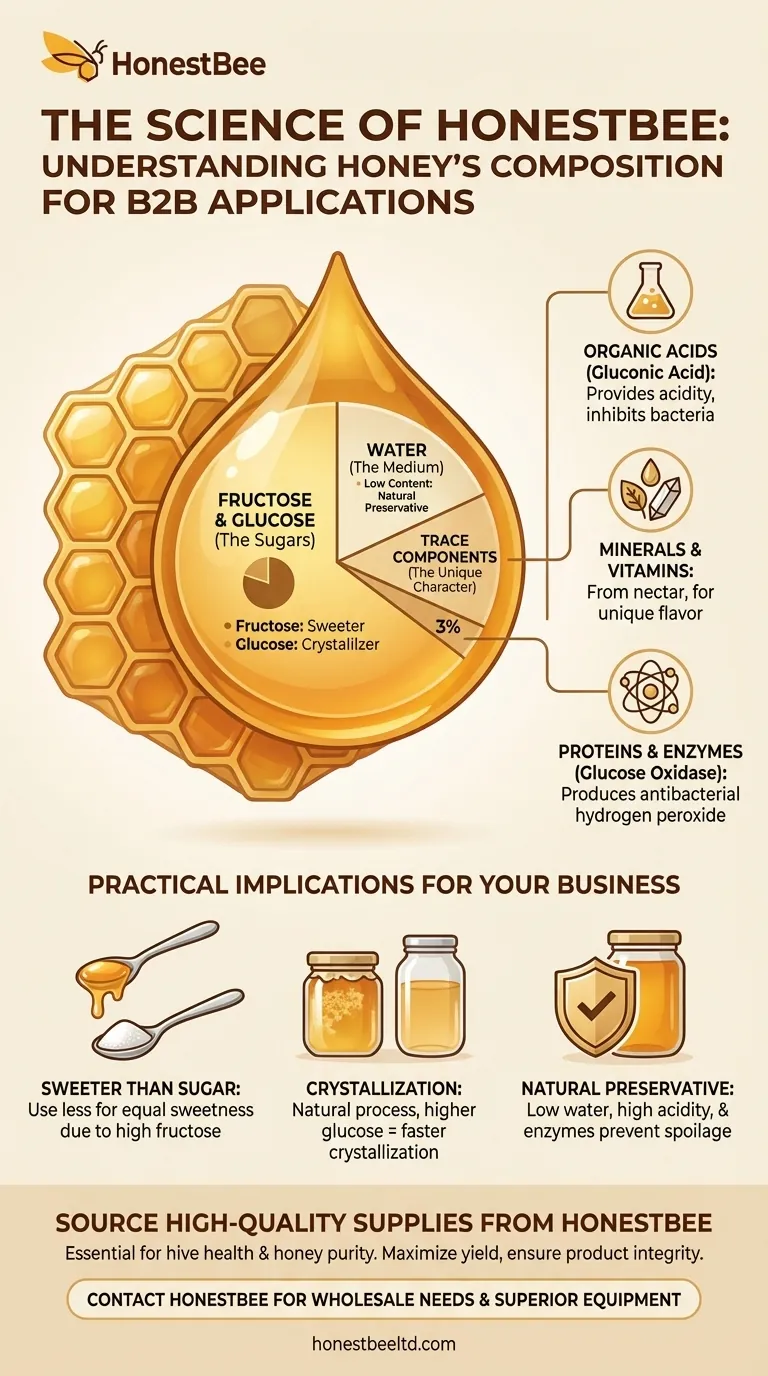At its core, honey is a supersaturated solution of sugars in water. Its primary components are the simple sugars fructose and glucose, which together account for the overwhelming majority of its composition. These are followed by water, with only trace amounts of other compounds giving honey its unique flavor, color, and aroma.
While honey is overwhelmingly composed of simple sugars and water, it is the small fraction of minor components—including acids, minerals, and enzymes—that gives each type of honey its unique character and powerful antibacterial properties.

The Core Building Blocks: Sugars and Water
Honey's fundamental properties are defined by three main ingredients. The specific ratio of these components determines its sweetness, viscosity, and tendency to crystallize.
Fructose (Fruit Sugar)
Fructose is the most abundant sugar in honey. It is significantly sweeter than glucose, which is the primary reason honey tastes sweeter than table sugar.
Glucose (Grape Sugar)
Glucose is the second most common sugar. While less sweet than fructose, its concentration is the main factor that determines whether honey will crystallize over time.
Water Content
Water is the third major component, typically making up a small percentage of honey's total volume. This low water content is critical, as it creates an environment where bacteria and other microbes cannot survive, making honey a natural preservative.
The Minor Components That Define Honey
Though present in very small quantities, these trace elements are responsible for honey's complexity and many of its most valued characteristics.
Organic Acids
Acids, primarily gluconic acid, give honey its characteristic mild acidity (low pH). This acidity is a key factor in inhibiting bacterial growth and contributes to its shelf stability.
Minerals and Vitamins
Honey contains trace amounts of minerals and vitamins that are derived from the nectar of the flowers visited by bees. These can include potassium, calcium, and B vitamins, though not in nutritionally significant quantities.
Proteins and Enzymes
A tiny fraction of honey consists of proteins and enzymes introduced by the bees themselves. One crucial enzyme, glucose oxidase, produces hydrogen peroxide, which is a major contributor to honey's well-known antibacterial properties.
Understanding the Practical Implications
The chemical makeup of honey directly influences how it behaves in your kitchen and why it has been valued for centuries.
Why Honey is Sweeter Than Sugar
Table sugar (sucrose) is a combination of glucose and fructose. Because honey has a higher proportion of the much sweeter fructose, you can often use less of it to achieve the same level of sweetness in recipes.
The Science of Crystallization
Honey that is higher in glucose relative to fructose will crystallize more quickly. This is a natural process and does not indicate spoilage; it is simply the glucose solidifying out of the supersaturated solution.
Natural Preservative Properties
Honey's resistance to spoilage is not accidental. It is the direct result of its low water content, its natural acidity, and the antibacterial compounds produced by its enzymes.
How This Affects Your Choice and Use
Understanding honey's composition allows you to select and use it more effectively based on your goals.
- If your primary focus is culinary sweetness: Remember that honey's high fructose content makes it taste sweeter than sugar, so you can often reduce the amount you use.
- If your primary focus is long-term storage: Honey's low water content and natural acidity make it exceptionally stable, meaning it will not spoil if sealed and stored properly.
- If your primary focus is health benefits: The trace enzymes and acids are responsible for honey's antibacterial properties, which are most potent in raw, unfiltered varieties.
By understanding these components, you can appreciate honey not just as a sweetener, but as a complex and functional natural product.
Summary Table:
| Component | Primary Function/Characteristic |
|---|---|
| Fructose & Glucose | Main sugars; determine sweetness and crystallization. |
| Water | Low content creates a natural preservative environment. |
| Organic Acids | Provide mild acidity, inhibiting bacterial growth. |
| Enzymes (e.g., Glucose Oxidase) | Produce hydrogen peroxide, contributing to antibacterial properties. |
| Minerals & Vitamins | Trace amounts from flower nectar, contributing to unique character. |
Source High-Quality Honey & Beekeeping Supplies from HONESTBEE
Understanding honey's composition is key to producing and selecting the highest quality product. For commercial apiaries and beekeeping equipment distributors, the right supplies are essential for maintaining hive health and honey purity.
HONESTBEE supplies durable, reliable beekeeping supplies and equipment through wholesale-focused operations, helping you maximize yield and ensure product integrity.
Contact HONESTBEE today to discuss your wholesale needs and learn how our equipment supports the production of superior honey.
Visual Guide

Related Products
- Professional Thermostatic Conical Honey Melter
- Honey Concentrating Vacuum Heating Thickening Machine Dehumidifier for Honey
- HONESTBEE 3-Frame Manual Acrylic Honey Extractor
- 10L Stainless Steel Electric Honey Press Machine
- 8-Frame Electric Self-Reversing Honey Extractor Spinner for Commercial Honey Extraction Equipment
People Also Ask
- What is melter honey used for? A Low-Cost Ingredient for Bakers and Brewers
- How to permanently decrystallize honey? Embrace Its Natural State for Maximum Quality
- How does the Bee Blanket help maintain honey quality? Preserve Enzymes with Gentle Hive-Mimicking Heat
- What equipment is commonly used for heating and processing honey? Essential Tools for Every Beekeeper
- At what temperature does honey flow? Preserve Quality with the Perfect 95°F Sweet Spot



















